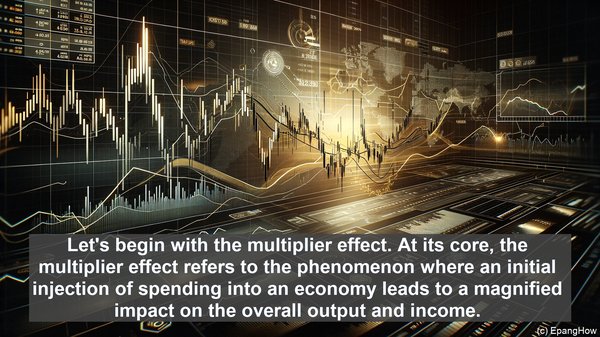Introduction: The Interplay of Economic Factors
Hello everyone, and welcome to our article on the multiplier effect and the accelerator effect. In the realm of economics, various factors come into play, shaping the dynamics of markets, investments, and overall economic growth. Two such factors are the multiplier effect and the accelerator effect. While they may sound similar, they represent distinct concepts, each with its own significance and implications. Today, we’ll explore these concepts, understand their differences, and examine how they influence economic systems.
The Multiplier Effect: Amplifying Economic Activity
Let’s begin with the multiplier effect. At its core, the multiplier effect refers to the phenomenon where an initial injection of spending into an economy leads to a magnified impact on the overall output and income. In simpler terms, it’s like a ripple effect, where a small pebble creates expanding waves. This effect occurs due to the interconnectedness of economic activities. When an individual or entity spends money, it becomes income for someone else. This recipient, in turn, spends a portion of it, creating income for another person, and so on. This chain continues, with each round of spending generating additional income. As a result, the total increase in income is greater than the initial injection. This concept is often associated with government spending, as it can have a significant multiplier effect, stimulating economic growth.
The Accelerator Effect: Investment Driving Growth
Now, let’s shift our focus to the accelerator effect. While the multiplier effect primarily deals with spending and consumption, the accelerator effect revolves around investment. It postulates that changes in investment levels can have a substantial impact on the overall economic output. The rationale behind this effect lies in the relationship between investment and the production capacity of an economy. When businesses invest in capital goods, such as machinery or infrastructure, it not only creates immediate demand for those goods but also enhances the economy’s productive capacity in the long run. This increased capacity, in turn, leads to higher output and income. Moreover, the accelerator effect works in a cyclical manner. When there’s a surge in demand due to factors like increased consumer spending, businesses respond by ramping up their investment, further fueling economic growth.

Distinguishing Factors: Multiplier vs. Accelerator
While both the multiplier effect and the accelerator effect contribute to economic expansion, there are key differences between the two. Firstly, in terms of the initial trigger, the multiplier effect is often set in motion by an external injection of spending, such as government expenditure. On the other hand, the accelerator effect is more closely tied to internal factors within the economy, particularly changes in investment levels. Secondly, in terms of the time frame, the multiplier effect is relatively immediate. The impact of the initial spending injection is felt in subsequent rounds, leading to a quick amplification of economic activity. In contrast, the accelerator effect operates over a more extended period, as it involves the process of investment, which takes time to materialize into increased output. Lastly, while the multiplier effect is more about the overall increase in income and output, the accelerator effect emphasizes the relationship between investment and the economy’s productive capacity.
Implications and Policy Considerations
Understanding the multiplier effect and the accelerator effect is crucial for policymakers and economists. It helps in formulating effective strategies to stimulate economic growth, especially during periods of recession or stagnation. For instance, during an economic downturn, a government can implement expansionary fiscal policies, such as increased public spending. This not only directly injects funds into the economy but also sets off the multiplier effect, as the additional income generated leads to more spending and, consequently, more economic activity. Similarly, by recognizing the significance of the accelerator effect, policymakers can focus on creating an environment conducive to investment, offering incentives, and ensuring stability, all of which can drive economic expansion. By harnessing the potential of both these effects, it’s possible to create a virtuous cycle of growth and prosperity.

